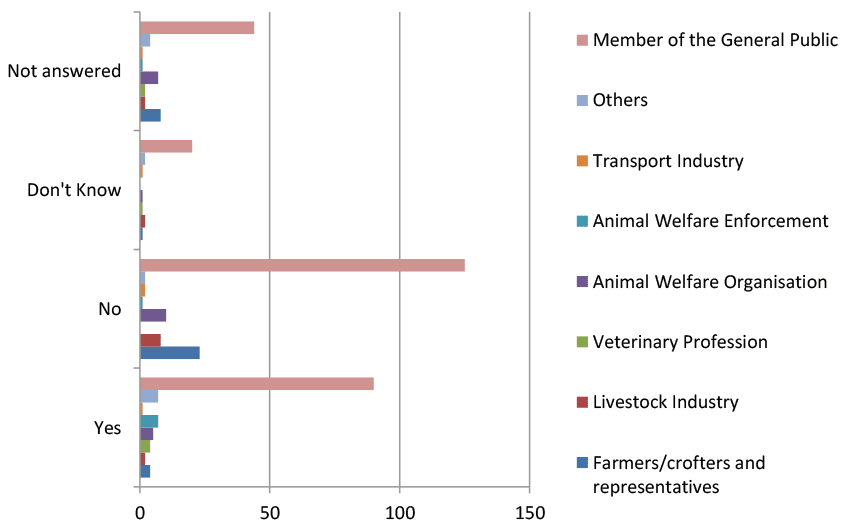Welfare of animals during transport - consultation: summary report
Analysis of the responses received to the full public consultation, between 4 December 2020 to 26 February 2021, of the Farm Animal Welfare Committee's opinion on the welfare of animals during transport.
Question 9
Do you agree with the Scottish Government’s position on thermal conditions and ventilation for animals in transport and proposed course of action? Please provide any further relevant information.
It is the view of the Scottish Government that thermal conditions and ventilation are a key aspect of welfare in transport and extreme temperatures and poor ventilation can cause animal welfare issues to arise.
We are keen that our requirements reflect the latest evidence and expert understanding. We agree in principle that FAWC’s recommended temperature ranges should be used as a guide in the way proposed by FAWC, and that further research and evidence would help inform further refinement of these parameters.
We agree that future regulatory requirements could include setting a maximum and a minimum external temperature for permissible journeys, that any new limits should be based on science and evidence, and that any regulatory requirements relating to these limits should also consider the ability of the vehicle to manage the temperature experienced by animals being transported.

Of the 319 responses to this question, 37.6% were in favour of the Scottish Government’s position on thermal conditions and ventilation for animals in transport and proposed course of action. 53.6% were not in favour and 8.8% did not express a view.
Many of those who supported the proposal agreed with the Scottish SPCA’s comment that “minimum and maximum internal temperatures within the animal carrying compartment should be based on scientific evidence taking into account the species and age of the animals”.
A number of recipients were critical of FAWC’s recommendations on thermal comfort, and others suggested that these “should be used as a guide in the way proposed by FAWC … further research and evidence would help inform further refinement of these parameters”. (OneKind). Scotland’s Rural College, and others, commented that the “lower temperature limit of 5 degrees C is not apparently based on scientific evidence , and an ambient outside temperature can be much colder than the temperature within a vehicle and as experienced by the animal”.
A number of respondents, both organisations and individuals, commented that “the lower limits of this temperature range should not be considered extreme in the context of Scotland” (unnamed organisation) and that “animals are used to living in their normal habitat in fields throughout winter” (Road Haulage Association) at lower temperatures.
It was also suggested by a number of respondents that there might be welfare problems associated with a lack of transport during periods outwith temperature ranges. For example, “flocks are taken indoors for parturition, where supervision can be given at lambing” (unnamed organisation) and travel restriction might make it difficult for them to be moved back to pasture to avoid “mis-mothering, physical injury and disease build up”. Others commented that “moving animals a short distance to accommodate extreme weather should not fall outwith the limits” (Scottish Crofting Federation).
A number of respondents also questioned the use of external temperatures, citing the current regulations as based on prohibiting livestock journeys where the “internal temperature is not maintained between 5 and 30 degrees C” which “we feel … provides enough of a safeguard from extreme temperatures” (Quality Meat Scotland).
There were additional suggestions made that any future temperature restrictions legislated upon should not necessarily reflect any science or evidence. An unnamed equine organisations suggested that any regulatory temperature range should have a “tolerance threshold of +/- 5 degrees”. An unnamed welfare organisation took an opposite approach suggesting a ““buffer” at the high and low ends of the scientifically demonstrated temperature ranges to ensure that animals are never subjected to temperatures beyond the acceptable extremes”.
Humidity was mentioned by a small number of respondents as a factor in “significant adverse effects on animal welfare” and suggesting transport should not take place if “the prognosed enthalpy value is above 60 kj/kg” (Humane Society International UK).
Contact
There is a problem
Thanks for your feedback